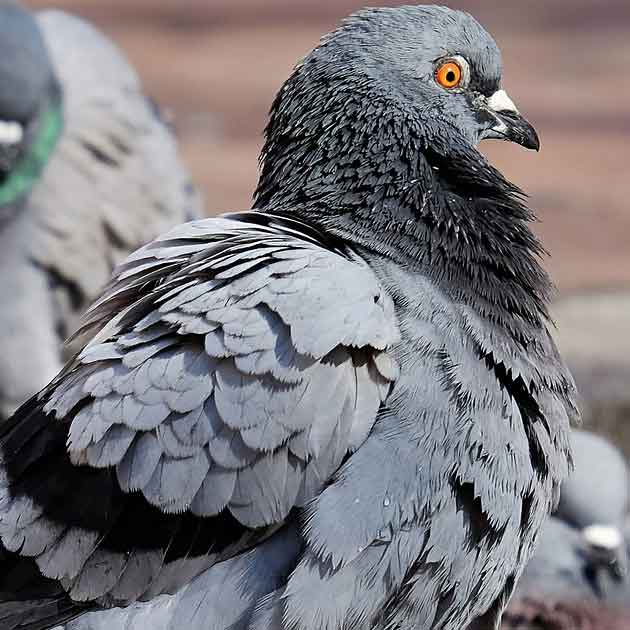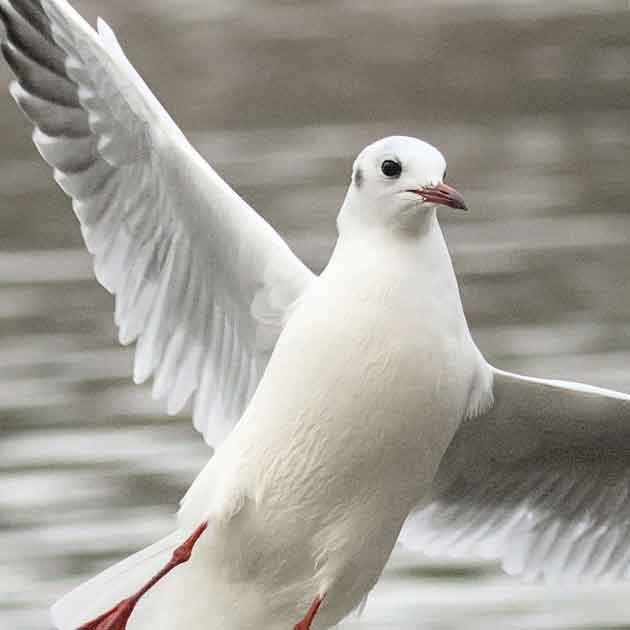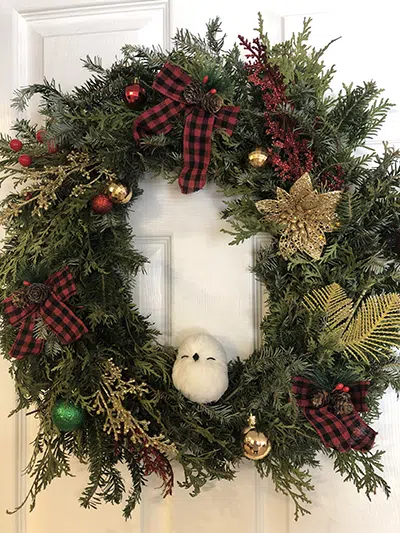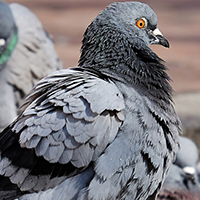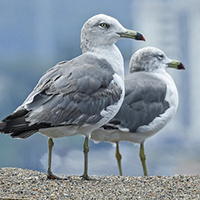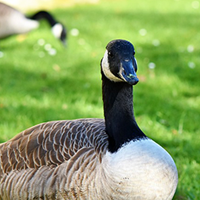Pigeons (Columba livia)
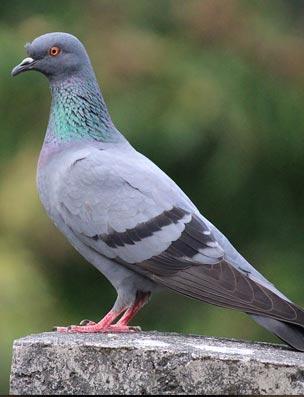 The pigeon is the top bird pest in urban centres; large numbers can be observed in every city across Canada, including Toronto. By now, pigeons have adapted fabulously to city life, have lost all fear of humans and happily nest and/or roost on all types of buildings and structures. They are found in groups of 50 to 500 and can lay eggs up to six times each year, depending on climate. Their success is largely due to their diverse diet which includes; grass seed, berries, scavenged human food, insects, caterpillars, spiders, as well as bird seed and bread fed by well meaning people.
The pigeon is the top bird pest in urban centres; large numbers can be observed in every city across Canada, including Toronto. By now, pigeons have adapted fabulously to city life, have lost all fear of humans and happily nest and/or roost on all types of buildings and structures. They are found in groups of 50 to 500 and can lay eggs up to six times each year, depending on climate. Their success is largely due to their diverse diet which includes; grass seed, berries, scavenged human food, insects, caterpillars, spiders, as well as bird seed and bread fed by well meaning people.
Pigeon Control and Removal Solutions
When it comes to pigeon control there are a variety of solutions which are dependent on factors such as accessibility, location, nesting, and amount of pigeons on site. These solutions include trapping, falconry, shooting, exclusion, nest and egg removal, and cleaning services. Pigeons have a great homing instinct and tend to go back to the same areas over and over to breed; especially if they have had a successful clutch in the same location. In situations where the pigeons have previously nested on the building in question, the best solutions are trapping and shooting which provide permanent removal of the birds, but exclusion techniques may need to be used instead depending on the location of the property and birds.
A multiple method approach is your best bet for a long term solution. The key to controlling and removing pigeons is to make the area unappealing to them by removing sources of food and making physical changes to their roosting and nesting areas. Coil, spring wire, spikes, bird points and netting are all additional solutions for pigeon control, but it takes an expert to know when, where and how to use them. Your location and the type of bird pressure will dictate the most appropriate control solutions.
We determine bird pressure to be light, medium, or heavy, dependent on whether the birds are nesting, just perching on the ledges of a building, or both. For each type of pressure there are different solutions that are most effective. Light pressure is when there is no nesting but birds are landing on signs, ledges, etc. Heavy pressure is when there is nesting and shelter from rain and wind in a specific area providing ultimate nesting conditions. Medium pressure usually does not consist of nesting, but describes an area that offers a food source, or a site that is more frequently visited and shows signs of droppings and moderate activity.
Trapping for Pigeon Control
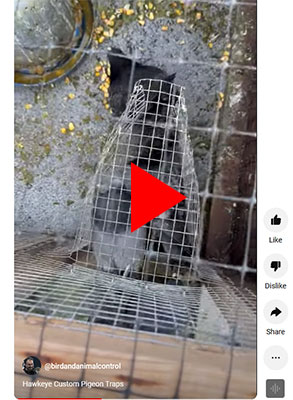 Pigeon trapping is one of our most popular and successful techniques when it comes to permanent pigeon removal. Typically pigeon traps are installed on the roof of a building, away from the public. Therefore, this solution works best when a customer is experiencing pigeon problems on their roof top or in an area with little human traffic (such as a balcony or gated area). Hawkeye uses proprietary pigeon traps - our own design and our own blend of pheromones, based on decades of experience. Carrying the scent of previously trapped pigeons provides a greater attraction to the trap and therefore a higher catch success rate than many metal cages that you may see. The pigeon traps are also baited with corn so that the pigeons will go here to feed and find themselves stuck in the trap. Trapping must be started early in the year - timing is critical.
Pigeon trapping is one of our most popular and successful techniques when it comes to permanent pigeon removal. Typically pigeon traps are installed on the roof of a building, away from the public. Therefore, this solution works best when a customer is experiencing pigeon problems on their roof top or in an area with little human traffic (such as a balcony or gated area). Hawkeye uses proprietary pigeon traps - our own design and our own blend of pheromones, based on decades of experience. Carrying the scent of previously trapped pigeons provides a greater attraction to the trap and therefore a higher catch success rate than many metal cages that you may see. The pigeon traps are also baited with corn so that the pigeons will go here to feed and find themselves stuck in the trap. Trapping must be started early in the year - timing is critical.
Advantages:
Permanent removal option
Effective for a large number of pigeons
Disadvantages:
Only effective for pigeons on rooftops or secluded areas
Ongoing service
Falconry for Pigeon Control
Falconry to control and remove pigeons is effective and appropriate outdoors as well as in large enclosed spaces, such as hangars, warehouses, industrial facilities, etc. Outdoors, a combination of other methods and falconry may be advantageous. A VERY skilled falconer is needed here, who can determine the strongest bird in the flock and send his bird of prey after that bird. The goal is to break the homing habit of the flock.
At Hawkeye, we house a variety of birds of prey which can be used for pigeon control including hawks, falcons, eagles, and owls. Falconry is used most often for pigeons on rooftops. This is a great technique for pigeons who haven’t already nested. Once they have nested they become significantly harder to remove with scare tactics and require a more permanent solution. The process of falconry includes a trained falconer flying a bird of prey at your job site which instills fear in the pigeons and encourages them to fly off and deem the area unsafe for nesting. The kill to scare technique may also be utilized in this situation in which our bird of prey will predate on one or more of the pigeons at the job site. This process increases the scare factor for the pigeons on site and encourages them to find an alternate perching and/or nesting location.
Advantages:
Environmental friendly
Humane
Can be used in combination with other techniques for maximum effectiveness
Disadvantages:
Weather permitting (cannot be used in rain, fog, strong winds)
Ongoing service
Does not prevent nesting of birds when falcon or hawk is not on site
Shooting
This technique uses lethal means to remove pigeons. This process does not work in every situation as many commercial buildings or housing facilities in the Toronto area are too highly populated for us to execute this. This technique is best used in rural areas or when a pigeon or other bird has entered into a factory. This process requires the whole area to be cleared of personal so is typically done after hours. Using high powered air rifles we have great success removing pigeons and other small birds from these areas and this is typically the only options for birds that are finding there way indoors.
Advantages:
Permanent Removal
Disadvantages:
Cannot be executed in all areas
Area must be cleared of personal and/or customers therefore can only be performed at specific times
Opportunistic (birds must be visible and on site during visit to be effective)
Types of Pigeon Exclusion Techniques
This technique can be effective in many different situations where shooting, trapping, and falconry are not options. The types of exclusion we use for pigeon control include netting, bird spikes, flex track, bird slide, optical gel, pigeon reproductive control, and many more depending on your particular situation. The type of exclusion necessary for your pigeon control solution depends on many factors including visual concern, accessibility, and nesting.
Netting
Netting is typically used to block access for birds to areas such as balconies and canopies. Depending on the bird, the spaces in the netting come in various sizes; but for the case of pigeons a 2” knotted netting is sufficient. This netting is black, heavy duty, polyethylene, 4-6 strand, knotted twine. Although this netting comes in a variety of colours, black is the most common and is the most inconspicuous when viewed from the ground level. Netting can be used to completely block off access for nesting or perching birds and is an excellent solution for high bird activity areas.
Advantages:
Long lasting solution
Humane
Effective for many bird species
Disadvantages:
Aesthetically changes the look of the building
Must be professionally installed
Bird Spikes
Bird spikes are an excellent exclusion method in areas where pigeons are not yet nesting. These spikes are made of durable stainless steel and come in a variety of lengths and widths to protect many areas including gutters, ledges, signs, and pipes. Bird spikes are only an effective solution in areas where pigeons are not already nesting. If they have already nesting in this area, it is likely they will just build their nest directly on top of the spikes.
Advantages:
Long lasting solution
Humane
Durable
Easy to install
Effective for many bird species
Disadvantages:
Aesthetically changes the look of the building
Not effective for nesting birds
Flex Track
Flex track is an extremely effective exclusion method, especially for those looking for a very low visibility option. Flex Track is an electrified track that is very configurable to any perching surface. This track is connected to a solar powered or battery run charger and emits a small non harmful shock to the birds that land on it. Although this shock is not harmful, it is powerful enough to prevent birds from landing on this track again.
Advantages:
Low profile solution (minimally visible)
Humane
Effective for many bird species
Disadvantages:
Must be professionally installed
Requires maintenance every couple years
Bird Slide
Bird slide is a great option for open cornered ledges. Bird slide is made from a UV-stabilized polycarbonate material and turns any flat ledges into an angled ledge so that birds are unable to perch. This form of exclusion is good for not only pigeons but works for all bird species. This is an excellent low profile option for exclusion because the material can be painted in any colour to match the surrounding.
Advantages:
Low profile solution (minimally visible)
Humane
Effective for many bird species
Disadvantages:
Must be professionally installed
Requires maintenance every couple years
Optical Gel
Optical Gel is a low profile deterrent that can be effective for perching birds and even nesting birds. These circular dishes are filled with a sticky material that deters pigeons in a multi-sensory way. These dishes visually appear as fire or smoke causing the birds to avoid the area completely. The dishes are easily installed using either magnets or glue and can be effective up to 4 years.
Advantages:
Low profile solution (minimally visible)
Humane
Effective for many bird species
Disadvantages:
Must be professionally installed
Requires maintenance every couple years
Pigeon Reproductive Control (Ovo Control)
Ovo Control is a humane control method to prevent the reproduction of pigeons that feed from the device. This device is excellent for large population areas such as industrial sites with flat roof tops. This birth control appears as a feed for the birds so it is easily ingested by the entire flock. Once the feed is ingested it prevents the fertilization of eggs. The pigeons will still create nests and lay eggs, but the eggs will not hatch. This feed is not poisonous or dangerous for the birds to ingest.
Advantages:
Humane
Reduces hatch rate therefore reduces size of pigeon flock over time
Various feeding methods
Disadvantages:
Continuous service (must be used through the entire breeding season)
Feed must be eaten everyday to be effective; impossible to monitor if each bird has eaten the feed each day
Nest and Egg Removal and/or Cleaning
It is common that all sites requiring pigeon control services also require nest and egg removal and/or cleaning. Since pigeons are not protected under Canadian Wildlife Services, nest and eggs can be removed without a permit. Once any nests and eggs are removed the areas in question can be cleaned using pressure washers and a diluted bleach solution. Pigeon droppings are so acidic that they can degrade many surfaces and they can also cause many illnesses when inhaled or ingested.
Advantages:
Pigeon population does not expand
Prevents building degradation
Disinfects areas of concern to protect from disease spread
Disadvantages:
Must be used in combination with other techniques to prevent from recurrence
Inspection
At Hawkeye we offer FREE inspections to properly gauge which pigeon control solutions work best for your particular situation. The solutions listed above are not one size fits all. An inspection is likely needed to provide the best possible solution that will be personalized to you. Please call us at 416 HAWKEYE to book your inspection today.
What Health hazards are associated with Pigeons?
Pigeons pose a health hazard to people as they carry Salmonella and Chlamydophila psittaci, a bacteria that causes psittacosis, a serious, although rarely fatal disease for humans.
The general public's affection toward birds translates into a serious underestimation of the health risks associated with pest birds...
Do Pigeons cause Physical damage?
Pigeons cause millions of dollars of damage in urban areas every year. Their feces contains uric acid which is extremely corrosive. Pigeon flocks nesting or roosting on a roof will seriously corrode the roofing materials, cutting its life in half. They cause extensive damage to rooftop machinery like air conditioning units. Other economic costs include slip and fall liability, product contamination and risk to company/building reputation as buildings are seen as unclean or unsanitary.
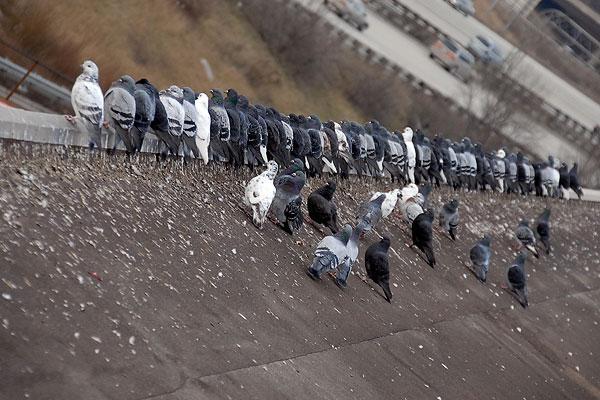
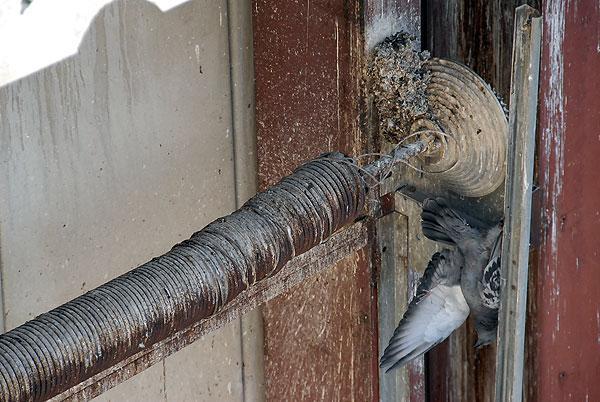
What is the life cycle of a Pigeon?
Pigeons do not migrate and they stay close to where they were born, making them determined to roost there. This tendency can cause a lot of grief for the inexperienced pest control company. Each day, pigeons spend the night roosting, feed in the morning and spend the afternoon loafing about, often excreting the digested food eaten that morning
When and how do Pigeons nest?
Pigeons build simple nests made up of a few twigs linked together. When part of a large flock, they may lay eggs directly on a protected surface. They will build nests on almost any raised, flat surface including; building ledges, bridges, air conditioner units and window sills. The female will lay several eggs at a time which take approximately eighteen days to hatch. Fledglings (baby birds) take just over a month to leave the nest.
Summary: Remove and deter pigeons through the use of trapping, falconry (birds of prey), netting, and ledge protection systems. Guaranteed Results!


